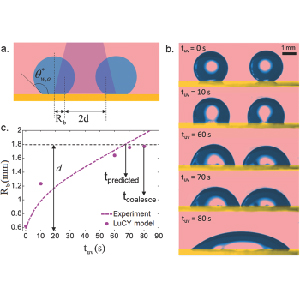Titanium dioxide (titania or TiO2) is well known for its photocatalytic properties and its ability to remove organic contaminants under UV light illumination. It is also known to switch its surface wetting characteristics from being hydrophilic to superhydrophilic under exposure to UV light in air. However, less is known about the switching of the hydrophilicity of TiO2 surfaces immersed in an oil medium. In this work, self-assembled TiO2 nanoparticle surfaces are immersed in an oil environment, and the kinetics of contamination-induced hydrophobicity and photoinduced hydrophilicity are studied using in situ contact angle measurements. A simple model is developed to relate the evolution in the measured contact angle to photocatalytically induced changes on the surface of nanoporous titania by integrating the Langmuir–Hinshelwood adsorption isotherm with the Cassie–Baxter analysis of the effective contact angle of a drop sitting on a composite surface. The resulting model can be used to predict and control wetting kinetics in drop coalescence applications. Moreover, it is shown that immersed oil–water separation membranes which have been fouled by low surface tension contaminants can be rapidly recovered in situ using this underwater photocatalytic reaction without the need for backwashing or harsh chemical reagents.
PDF: Download the PDF

